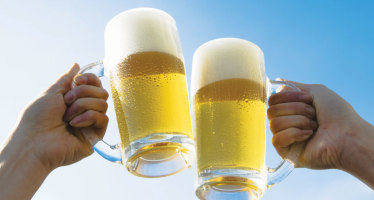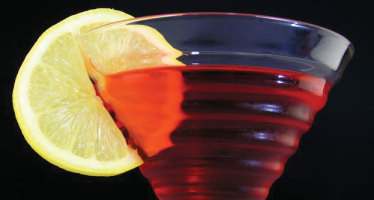Ice, Ice Baby

Lately, if you’ve been to a craft bar, you’ve had a drink with a giant cube or a large sphere of ice in it. Some places have even started using spears of ice for the tall Collins glass. What’s the deal with these large cubes, gigantic spheres, and tall cylinders? Why do we care whether it’s crushed into a fine powder, cracked into the familiar small cubes, or just one cube big enough to fill up the glass? Does the shape even matter? Just what the heck is going on with our ice in cocktails?
Given this issue of Food & Spirits Magazine celebrates five years of FSM, let’s first get a little perspective. The Omaha of five years ago was certainly no stranger to the cocktail, but we didn’t have any bartenders who had places to practice the craft of bartending professionally. Sure, we had our places to go drink, and we wouldn’t hesitate to order a Manhattan, or a Negroni, or an Old Fashioned; we were content with what we had. New York, Seattle, San Francisco and Chicago were the places where bartenders were becoming as chefs behind the stick, but it hadn’t yet reached Omaha.
Four years ago we saw the craft of bartending starting to catch on in our fair city, started hearing about this word mixology. It’s about a balanced cocktail, about serving a quality drink, and about bartending becoming a craft once again. Now there’s a lot of talk going around about ice. We’re seeing ice presses which make spheres, tall spears for our Collins’ glasses, and words such as Kold-Draft are starting to be whispered and talked about. This is an exciting time for Omaha. It’s a time to go out and get a real mixed drink.
Water in cocktails is about bringing balance to the drink. When you think that just about every mixed drink, other than the shot or pousse café, has about 40-60% of its volume as water, you can begin to appreciate that it plays as vital a role as the spirits and other ingredients that go into the concoction. Water will bring flavors out, push flavors back, and do fun stuff to a drink. Add too much and the drink falls flat, add too little and it’s going to have harsh notes and burn a little. What does this have to do with ice? In the cocktail universe, ice is how we deliver water into a cocktail.
There are three reasons why we shake and stir drinks. (1) Mix the ingredients together, (2) chill the drink to palatable levels, and (3) introduce water to dilute the drink. Ice plays a key role in each of these processes, and plays a critical role once the drink gets served.
When we use ice to make drinks, the type of ice we use is important. For drinks like frappes, blended drinks, and juleps, we want to use crushed ice or powder. This ice melts very quickly, distributing water into the drink at a rapid rate and thus cooling the drink quickly. Usually these drinks get swizzled (the most violent form or stirring) to integrate everything. These will be the coldest beverages you get, the ones that can be the most desirable on a hot day.
For other drinks we use cracked ice. Here, think of the ice we’re used to, the standard ice from the bar and the ice in our home freezer. It comes in varying sizes, but generally speaking we get several cubes into the glass. The type of glass best suited to using these cubes is your highball, tumbler or Collins glass. It’s ideal for drinks like the Tom Collins, the Americano Highball, the Moscow Mule, or the Dark and Stormy. This ice, in my opinion, is also the best ice to use in your shaking tin or mixing glass when making a drink. You can work pretty quickly with it and still have good control over your dilution and temperature.
Then we have the lump ice. These are the big blocks, the ones that we use in our old fashioned glasses. These melt slowly, have a more constant temperature, and we use them to maintain a drink.
Then there are the spears, which are a relatively new ice shape in the glasses. These are used in the Collins and the Highball glasses, and they serve the exact same purpose as the lump ice.
For those of us who practice the craft, we don’t just use these different types of ice because it looks cooler, although, let’s be honest, it does. While we still look to their notes for guidance, I would argue that with our understanding we’ve surpassed the likes of Jerry Thomas, Kappeler, McElhone, and Craddock, who probably used these different types of ice because it was easier than to try to create all these uniform pieces of cracked or lump ice. We use these different types of ice because it makes a better, more balanced drink for our customers.
Related Articles
Beer Chat: Raising a Toast to Nebraska’s A+ Offerings
We are blessed in Nebraska – great beer is not in short supply here. Let’s raise a toast to the
Sodas in Which You May Not Be Entirely Aware of: Royal Crown Cola
“God is going to get you.” That is just one of the crazy remarks I have received from customers at
Omaha’s Best Cosmopolitans
Ask any woman what her favorite cocktail is, and chances are she’ll say the Cosmo. A Cosmopolitan is a delicious
No comments
Write a commentOnly registered users can comment.














